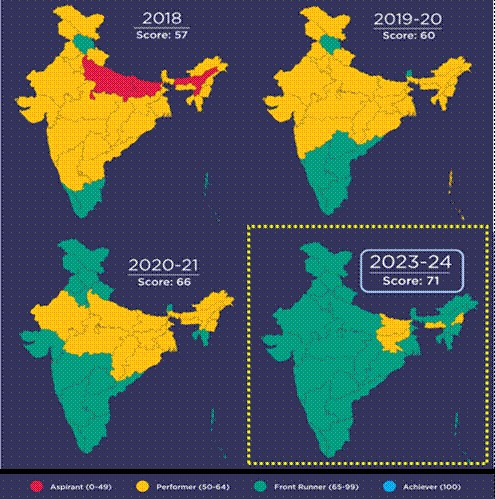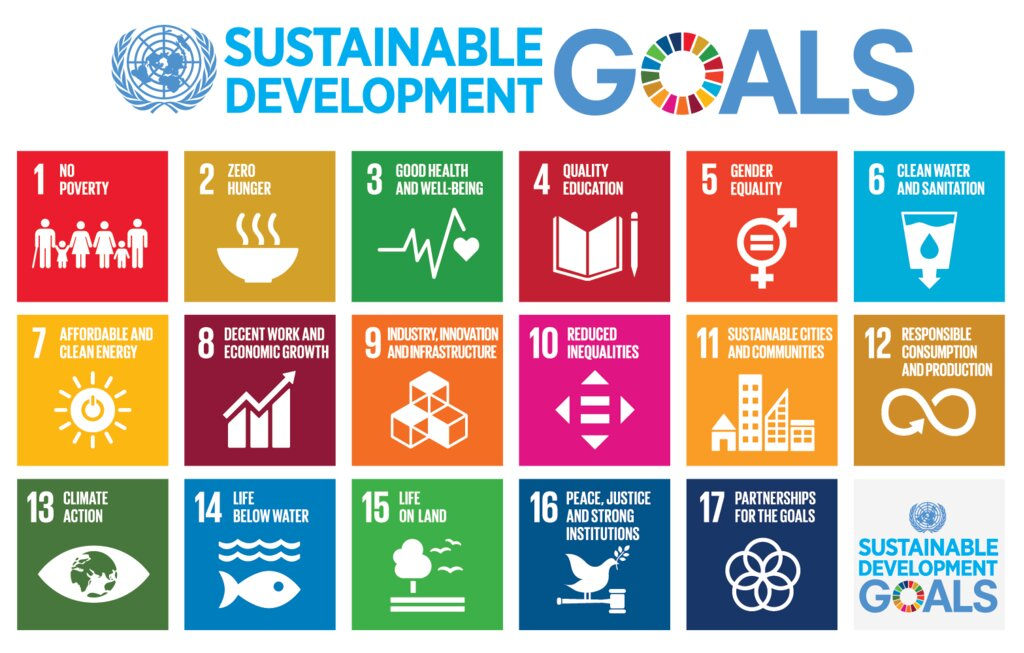Governance
Sansad TV Vishesh: SDG Report 2023-24
- 01 Aug 2024
- 16 min read
For Prelims: SDG India Index 2023-24, Sustainable Development Goals (SDGs), NITI Aayog, Poverty and Inequality, World Inequality Report 2022, National Family Health Survey 5, Global Hunger Index 2023, World Health Organization (WHO), National Statistical Commission, Gender Gap Report 2024, Climate Change Performance Index (CCPI) 2024, Economic Survey 2023-24 , Food Security, Pradhan Mantri Awas Yojana, Swachh Bharat Mission, Ujjwala Yojana, Jal Jeevan Mission, Ayushman Bharat-PMJAY, Ayushman Arogya Mandir, PM Mudra Yojana, Saubhagya Scheme, Renewable Energy, National Food Security Act (NFSA), Direct Benefit Transfer (DBT), Skill India Mission, MGNREGA, MSMEs, Ayushman Bharat.
For Mains: Significance of the Government Policies & Interventions in achieving Sustainable Development Goals (SDGs) and Inclusive Growth.
Why in News?
Recently, the SDG India Index 2023-24, which is the fourth edition of the nation's primary tool for tracking progress on the Sustainable Development Goals (SDGs) at both national and state levels, was released by NITI Aayog.
What Progress has been Made on Sustainable Development Goals (SDG)?
- About:
- The SDG India Index, developed by NITI Aayog since 2018, tracks India's progress towards the UN’s Sustainable Development Goals (SDGs).
- It helps states integrate these goals into their development plans and provides a benchmark for policymakers to address gaps and prioritize actions for achieving sustainable development by 2030.
- The Index evaluates the performance of states and union territories (UTs) across 16 SDGs using 113 indicators aligned with national priorities.
- Overall Progress:
- India's SDG score increased to 71 in 2023-24, up from 66 in 2020-21 and 57 in 2018.
- Every state has shown improvements in their overall scores, largely due to targeted government efforts in areas such as poverty reduction, economic growth, and climate action.
- Significant improvements were observed in Goals 1 (No Poverty), 8 (Decent Work and Economic Growth), and 13 (Climate Action).
- Among these, Goal 13 (Climate Action) has made the most notable improvement, with its score rising from 54 to 67 and Goal 1 (No Poverty) also showed significant progress, with its score increasing from 60 to 72.
- These advancements highlight the impact of targeted interventions and initiatives by both Union and State Governments in enhancing citizens' lives.
- Top Performers:
- Kerala and Uttarakhand have emerged as the leading states, each achieving a score of 79 points.
- Lowest Performer:
- Bihar has fallen behind with a score of 57 points, with Jharkhand following at 62 points.
- Front-Runner States:
- A total of 32 states and union territories (UTs) are now classified as front-runners, including 10 new additions such as Arunachal Pradesh, Assam, Chhattisgarh, and Uttar Pradesh.
| SDG Goal | Key Highlights |
| Goal 1 – No Poverty |
|
| Goal 2 – Zero Hunger |
|
| Goal 3 – Good Health and Well-being |
|
| Goal 4 – Quality Education |
|
| Goal 5 – Gender Equality |
|
| Goal 6 – Clean Water and Sanitation |
|
| Goal 7 – Affordable and Clean Energy |
|
| Goal 8 – Decent Work and Economic Growth |
|
| Goal 9 – Industry, Innovation and Infrastructure |
|
| Goal 10 – Reduced Inequalities |
|
| Goal 11 – Sustainable Cities and Communities |
|
| Goal 12 – Responsible Consumption and Production |
|
| Goal 13 – Climate Action |
|
| Goal 15 – Life on Land |
|
| Goal 16 – Peace, Justice and Strong Institutions |
|
What are Challenges in Achieving SDG Targets ?
- Poverty and Inequality: Despite economic growth, a significant portion of the population still lives in poverty and inequality.
- For instance, according to the World Inequality Report 2022, India is among the most unequal countries in the world, with the top 10% and top 1% of the population holding 57% and 22% of the total national income respectively.
- Hunger Issue: Malnourishment and hidden hunger is a serious issue among the Indian population.
- For instance, as per National Family Health Survey 5, 25 % of men and 57 % of women (15-49 years) 67.1% of children (6-59 months) are anemic.
- Also, according to Global Hunger Index 2023, India’s 2023 GHI score is 28.7, considered serious according to the GHI Severity of Hunger Scale.
- Healthcare Access: Ensuring universal health coverage and improving healthcare infrastructure remain ongoing challenges.
- For example, as per National Health Profile 2021, India has 0.6 beds per 1000 population while the World Health Organization (WHO) recommends five hospital beds for every 1,000 people.
- Education Quality: While enrollment rates have improved, the quality of education and retention rates need attention.
- For instance, according to the Census of India 2011, the average literacy rate was 73%, whereas the National Statistical Commission's survey reported a literacy rate of 77.7% for 2017–18. The illiteracy across the rural and urban landscape and gender is more glaring.
- Gender Inequality: Disparities in education, employment, and efforts to improve social status, gender inequality persists.
- This is reflected in the fact that India ranks 127th in 2023 out of 146 countries in Gender Gap Report 2024 India has slipped two places in the global rankings.
- Climate Change and Environmental Degradation: Balancing development with environmental sustainability is a major challenge.
- For instance, India's secured 7th position in the Climate Change Performance Index (CCPI) 2024, however, according to IQAir, India is the 3rd most polluted country in the world and 42 cities in the top 50 are Indian.
- Urbanization: Rapid urban growth strains infrastructure and services in cities.
- For example, by 2036, 600 million people (40% of the population) will live in urban areas, up from 31% in 2011 but mushrooming slums, poor drainage, pollution and traffic congestion are common problems across all urban centers in India.
- Unemployment: Creating enough quality jobs for a growing workforce is an ongoing issue.
- As per the Economic Survey 2023-24 stated that the annual unemployment rate for individuals aged 15 and above has been on a downward trend since the Covid-19 pandemic.
- It noted that the youth unemployment rate has dropped from 17.8% in 2017-18 to 10% in 2022-23.
- Agricultural Productivity: Improving farm yields while ensuring sustainability is crucial for food security.
- For instance, the share of agriculture in the total Gross Value Added (GVA) of the economy has declined from 35% in 1990-91 to 15% in 2022-23.
- Governance and Implementation: Effective policy execution and coordination between different levels of government can be challenging.
What have been Government Interventions?
Some of the government interventions to achieve SDG targets and inclusive development and corresponding progress made are :
- Pradhan Mantri Awas Yojana: Over 4 crore houses have been built.
- Swachh Bharat Mission: 11 crore toilets and 2.23 lakh community sanitary complexes have been constructed.
- Ujjwala Yojana: 10 crore LPG connections have been provided.
- Jal Jeevan Mission: Tap water connections in over 14.9 crore households have been provided.
- Ayushman Bharat-PMJAY: Over 30 crore beneficiaries have been identified and linked to the scheme.
- Ayushman Arogya Mandir: Access to 150,000 beneficiaries have been provided which offers primary medical care and provides affordable generic medicines.
- PM Mudra Yojana: 43 crore loans have been sanctioned.
- Saubhagya Scheme: 100% of households have been electrified.
- Renewable Energy: Solar power capacity has increased from 2.82 GW to 73.32 GW in a decade.
- National Food Security Act (NFSA): Coverage of over 80 crore people.
- Direct Benefit Transfer (DBT): Rs. 34 lakh crore have been made through PM-Jan Dhan accounts.
- Skill India Mission: Over 1.4 crore youth have been trained and upskilled and 54 lakh youth has been reskilled.
The Sustainable Development Goals (SDGs)
- The Sustainable Development Goals (SDGs) are 17 global objectives established by the UN in 2015 as part of the 2030 Agenda for Sustainable Development.
- Building on the Millennium Development Goals, the SDGs offer a broad framework to tackle social, economic, and environmental challenges, aiming for a sustainable future.
- They cover issues like poverty, education, health, gender equality, and environmental protection, requiring collective action and collaboration across all sectors to achieve an equitable and sustainable world.
Way Forward-
- Poverty and Inequality:
- Healthcare Access
- Enhance primary healthcare by increasing centers and essential medicines, and expand Ayushman Bharat coverage.
- Utilize public-private partnerships for rural healthcare services and leverage digital health technologies for improved access and disease management.
- Education Quality
- Upgrade teacher training programs and school infrastructure, and expand access to early childhood education.
- Integrate digital tools in classrooms and ensure inclusive education for marginalized and disabled children.
- Gender Inequality
- Advance women's empowerment through education, employment, and leadership roles, and strengthen legal protections against gender-based violence.
- Climate Change and Environmental Degradation
- Increase the use of renewable energy sources and expand forest cover through afforestation.
- Implement stricter pollution controls and promote sustainable agricultural practices to mitigate climate change impacts.
- Agricultural Productivity
- Promote modern agricultural technologies and expand irrigation facilities to enhance productivity.
- Strengthen market linkages for farmers and invest in research for high-yield, climate-resilient crops.
- Governance and Implementation
- Empower local governments through decentralization and enhance officials' capacity with targeted training.
- Establish robust monitoring systems and foster public-private partnerships to improve service delivery and governance transparency.
UPSC Civil Services Examination, Previous Year Question (PYQ)
Prelims:
Q. Consider the following statements: (2016)
1. The Sustainable Development Goals were first proposed in 1972 by a global think tank called the ‘Club of Rome’.
2. The Sustainable Development Goals have to be achieved by 2030.
Which of the statements given above is/are correct?
(a) 1 only
(b) 2 only
(c) Both 1 and 2
(d) Neither 1 nor 2
Ans: (b)
Mains:
Q. National Education Policy 2020 is in conformity with the Sustainable Development Goal-4 (2030). It intends to restructure and reorient the education system in India. Critically examine the statement.(2020)
Q. “Access to affordable, reliable, sustainable and modern energy is the sine qua non to achieve Sustainable Development Goals (SDGs).” Comment on the progress made in India in this regard.(2018)






